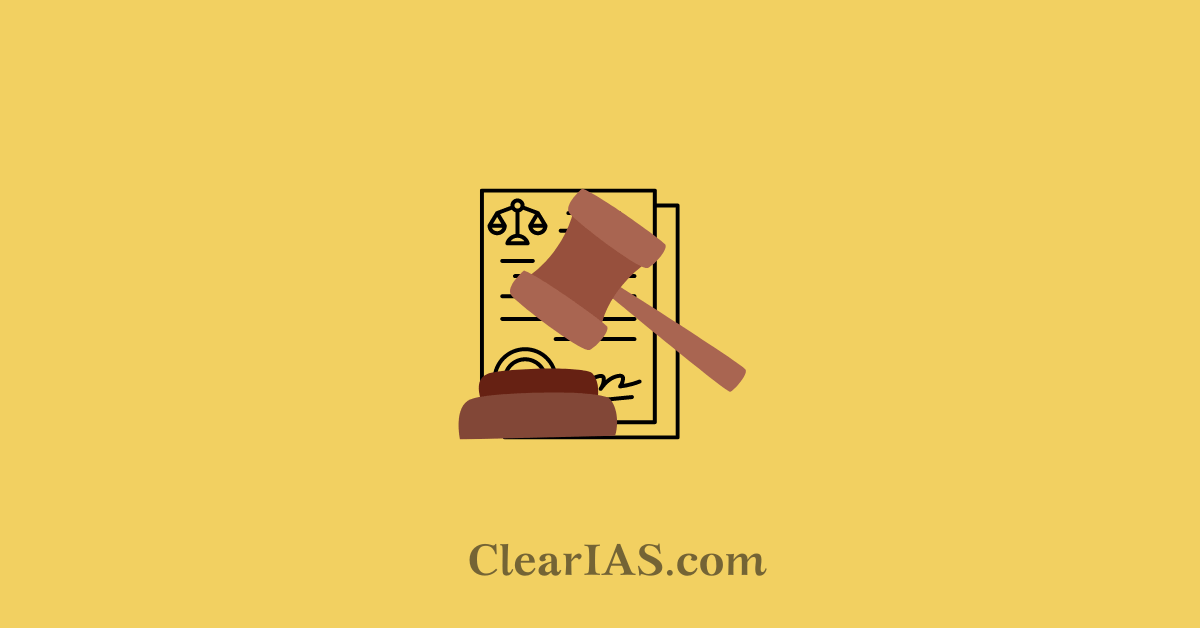
What is the First Amendment Act of 1951? What led to the 1st Constitutional Amendment? Read to know more.
The First Amendment was passed in 1951 by the Provisional Parliament, which was elected on a limited franchise.
Recently the Supreme Court of India agreed to examine a PIL challenging changes made to the right to freedom of speech and expression by the First Amendment Act 1951. This has sparked a nationwide debate.
The petitioner contends that the First Amendment damages the basic structure doctrine of the Constitution of India, impacting the freedom of speech and freedom to trade.
The petitioner has also claimed that the amendment also neglects national security by dropping the expression ‘tends to overthrow the State’, which raises grave concern in the context of the dangers posed to the concept of the secular democratic republic by radicalism, terrorism, and religious fundamentalism.
First Amendment Act 1951
The Constitution (First Amendment) Act, 1951 is the official name of the amendment. Jawaharlal Nehru, who was India’s prime minister at the time, made the motion on May 10 of that year, and Parliament passed it on June 18 of the same year.
This Amendment established a precedent for rewriting the Constitution to override judicial decisions that prevented the government from carrying out its alleged obligations to specific policies and programs.
The 1951 First Amendment Act amended the Fundamental Rights clauses of the Indian Constitution in several ways.
It gave ways to limit freedom of speech and expression, supported measures to abolish zamindari, and made it clear that the right to equality does not preclude passing laws that give “particular consideration” to society’s most vulnerable groups.
The Statement of Reasons (SOR) relating to the First Amendment said: “Challenges to agrarian laws or laws relating to land reform were pending in courts and were holding up large schemes of land legislation through dilatory and wasteful litigation.”
- The First Amendment Act amended articles 15, 19, 85, 87, 174, 176, 341, 342, 372, and 376.
- It also provided for the saving of laws providing for the acquisition of estates.
- Added three more grounds of restrictions on freedom of speech and expression order, friendly relations with foreign states, and incitement to an offense. Also, it made the restrictions ‘reasonable’ and thus, justiciable.
- Provided that state trading and nationalization of any trade or business by the state is not to be invalid on the ground of violation of the right to trade or business.
- It added the Ninth Schedule to protect the land reforms and other laws included in it from judicial review.
- Articles 31A and 31B were inserted after Article 31.
Major modifications
The primary objective of the First Amendment Act was to address certain legal and constitutional challenges that arose in the early years of the Republic of India. It aimed to modify specific provisions of the Constitution to overcome legal hurdles and better align with the evolving needs of the nation.
- Land Reform and Right to Property:
- One of the significant changes introduced by the First Amendment Act was related to the right to property. Article 19(1)(f) and Article 31 of the Constitution, which dealt with the right to acquire, hold, and dispose of property, were amended. The amendment aimed at providing the government with the authority to impose reasonable restrictions on the right to property for land reform and the acquisition of property for public welfare.
- Freedom of Speech and Expression:
- The First Amendment Act also made changes to Article 19(2), which deals with reasonable restrictions on the freedom of speech and expression. The amendment aimed at clarifying and broadening the scope of permissible restrictions on free speech to include matters related to public order, security of the state, and relations with foreign countries.
- Special Provisions for Advancement of Scheduled Castes and Scheduled Tribes:
- The amendment inserted Article 15(4) and Article 16(4) to provide for special provisions for the advancement of socially and educationally backward classes, including Scheduled Castes and Scheduled Tribes. These provisions allowed the government to make reservations in educational institutions and public employment to promote the interests of these communities.
- Validation of Certain Acts and Regulations:
- The First Amendment Act included a provision (Article 31A) to validate certain laws related to land reform and the abolition of zamindari systems, even if they infringed upon property rights. This was done to shield such laws from legal challenges.
- Power of the State to Make Special Provisions:
- The amendment also added Article 46, which directs the state to promote with special care the educational and economic interests of Scheduled Castes, Scheduled Tribes, and other weaker sections of the society.
What led to the amendment?
When the government faced harsh press criticism in 1950 for its response to the refugee inflow in West Bengal and the extrajudicial killings of communist dissidents in Madras, the necessity to limit freedom of speech emerged.
The government suppressed the press, but the courts ruled that this was unconstitutional, compelling the government to find alternative solutions.
According to Article 31’s provisions, laws listed in the Ninth Schedule cannot be contested in court because they infringe upon citizens’ basic rights.
The State now has extensive authority to purchase estates or take over the operation of any corporation or property in the public interest under Article 31(A). It attempted to keep such purchases out of the purview of judicial review under Articles 14 and 19.
Misuse of the Ninth Schedule was widespread. More than 250 laws are listed in the ninth schedule, which shields them from judicial review.
Although the Supreme Court ruled in the Kesavananda Bharati case of 1973 that judicial review cannot be abolished as a fundamental structure, Articles 31(A), 31(B), and 31(C) preserved land reform laws and prioritized the application of the Directive Principles over individual liberty.
1st Constitutional Amendment Act in the news
The Supreme Court has agreed to examine a PIL challenging changes made to the right to freedom of speech and expression by the First Amendment to the Constitution in 1951, with the petitioner contending that the amendment damages the basic structure doctrine.
In his plea, the petitioner said:
- Section 3(1) of the 1951 Amending Act substituted original Clause (2) of Article 19 dealing with reasonable restrictions on the freedom of speech and expression guaranteed under Article 19(1)(a) with a new Clause (2), which contained “two objectionable insertions” allowing restrictions also “in the interest of public order” and “about incitement to an offence”.
- The new Clause (2) also omitted the expression “tends to overthrow the State” as appeared in the original Clause (2).
The plea urged the court to declare Section 3 (1)(a) and 3 (2) of the First Amendment “beyond the amending power of Parliament” and void since the “same damage the basic or essential features of the Constitution and destroy its basic structure”.
Read: The Changing Constitution Since Independence-The Hindu
Way forward
The implications of the First Amendment Act 1951 have been a reason for numerous political debates on the relevancy and sanctity of democracy.
The ninth schedule has become controversial due to its absolute exemption from judicial scrutiny. This has led to the misuse of the laws several times.
Hence, it is a positive approach to revisit the amendment to rectify the shortcomings.
-Article written by Swathi Satish






Leave a Reply